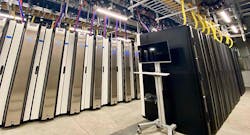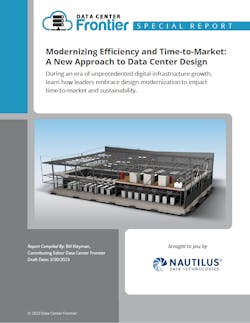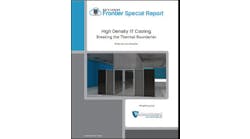From Modernization to Modular: Adapting to New Industry Norms
Last week we launched our article series on how modular design and sustainability both play a significant role in data center modernization efforts. This week we'll explore key considerations for modular data centers.
In the past, data center leaders would build extensive facilities and wait for them to be filled up.
Welcome to the future. We don’t build data centers like that any longer.
The key to sustainable and profitable growth for colocation providers is to open and lease each phase of the data center as quickly as possible to start leveraging their investment and generating revenue.
For that reason, many colocation providers are building their data centers in smaller blocks to open one section while they begin building the next. This limits the upfront investment and the time before revenue generation begins. It also allows providers to secure tenants earlier, essential in competitive, fast- paced environments.
On that note, keeping pace with a digital market is not always easy. Two of the biggest reasons typically listed for the problem with data centers are capital and speed of deployment. The traditional brick-and- mortar data center takes a lot of money and time to build. Furthermore, the quick evolution of supporting technologies further entices organizations to work with fast and scalable modular designs.
Outside of those two primary drivers, there are many benefits and reasons listed for why a modular data center approach is selected.
Modular Data Center Key Considerations
In a world driven by digital solutions, ensuring you can meet the market’s demands has become more complicated. Leaders in the edge, cloud, and data center space have looked to modular designs to ensure they can meet emerging requirements. Let’s examine some key benefits and considerations related to modular architecture.
Modular as a Concept, Not a Construct
Working with next-generation modular design requires a different approach to constructing critical infrastructure. First, modular ecosystems are a true concept because there is so much flexibility in how it’s designed and deployed. You have the freedom to ensure that your design meets business requirements.
With that in mind, let’s explore key concepts surrounding modular infrastructure.
- Speed of Deployment: Modular solutions have rapid timeframes from order to As a standardized solution, it is manufactured, ordered, customized, and delivered to the data center site in months (or less). Having a module manufactured also means the site construction can progress in parallel instead of a linear, dependent transition. Remember, this isn’t a container – rather a customizable solution capable of quickly being deployed within an environment.
In a study conducted during the recent DCD>Building at Scale conference, 39 percent of professionals working in the data center industry said that projects are being deployed in under a year and 66 percent in under 18 months. Data center designers must select more scalable solutions to keep up with this demand.
These lead times are significantly shorter than a decade ago, when data center projects stretched well over two years, a build strategy that simply would not meet the data demand of today’s rapidly growing market.
- Scalability: To ensure your data center design is modular and scalable, it is essential to select scalable With a repeatable, standardized design, it is easy to quickly match demand and scale infrastructure. The only limitations on a modular data center scale are the supporting infrastructure at the data center site and available land. Another characteristic of scalability is its flexibility, with modules that can be easily replaced when obsolete or if updated technology is needed.
This means organizations can forecast technological changes very few months in advance. So, a cloud data center solution doesn’t have to take years to plan out.
- Agility and speed-to-market: Quickly building a data center environment doesn’t only revolve around the ability to Being agile with data center platforms means quickly meeting an evolving business’s needs. Whether that means providing a new service or reducing downtime – modular data centers are directly designed around business and infrastructure agility. Some organizations build their modular environment for capacity planning; others leverage modular data centers for highly effective disaster recovery operations.
- Density and PUE: Density in a traditional data center is typically 100 watts per square foot. The space is used efficiently in a modular solution and features densities of 20 kilowatts per cabinet or The PUE can be determined at commissioning, and because the module is pre-engineered and standardized, the PUEs can be as low as 1.1 – 1.4. The PUE metric has also become an excellent data center green efficiency gauge. Look for a provider that strives to break the 1.25-1.3 barriers or at least one in the +/- 1.2 range.
The good news is that data center leaders are already pushing that PUE as low as it can go. For example, Nautilus water-cooled data center design has the lowest validated Power Utilization Effectiveness (PUE) of any commercial data center, reducing carbon emissions and energy usage by up to 30%. Their patented cooling technology utilizes a heat sink with an open and closed water loop. As a result, Nautilus data centers have a guaranteed PUE of 1.15 or better globally in most locations.
Finally, in terms of density, much of the industry still hovers between 10-20 kw/rack. New designs are taking power and density to entirely new levels. Working with partners like Nautilus will allow you to deliver high-density power up to 55kW a rack with rear door cooling or 100kW per rack when paired with liquid cooling technologies, with diverse primary and reserve distribution to each hall.
- Efficiency: The fact that modules are engineered products means that internal subsystems are tightly integrated, resulting in efficiency gains in power and cooling in the module. First-generation and pure I.T. modules will likely not have efficiency gains other than those enjoyed from a similar containment solution inside a traditional data Having a modular power plant close to the I.T. servers will save money in costly distribution gear and power loss from being so close. There are opportunities to use energy management platforms within modules, with all subsystems being engineered as a whole.
- Security and compliance: Our infrastructure is critical to our operations. Whether the data center is a sizeable hyperscale facility or an edge modular data center, uptime and resiliency are According to the Uptime Institute’s 2022 Outage Analysis, the consequences and cost of downtime are worsening, with 60% of failures now resulting in at least $100,000 in total losses. Look for partners that carry vital security metrics and compliance qualifications. For example, Nautilus complies with SSAE 16 SOC 2 Type 2, ISO 27001, PCI-DSS 2.0, NIST (800-171), and HIPAA. They also maintain their facilities with on-premise 24/7/365 security teams, multi-factor authentication, and intentional construction design to ensure your data is secure.
Download the entire report, Modernizing Efficiency and Time-to-Market: A New Approach to Data Center Design, featuring Nautilus Data Technologies, to learn more. In our next article, we'll dive into how new and innovative modular designs now support zero water consumption, zero refrigerants, and zero chemicals and cause no harm to the water or wildlife.







